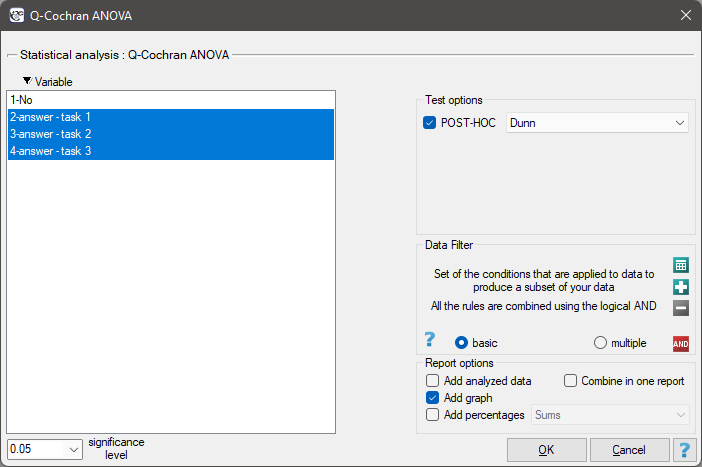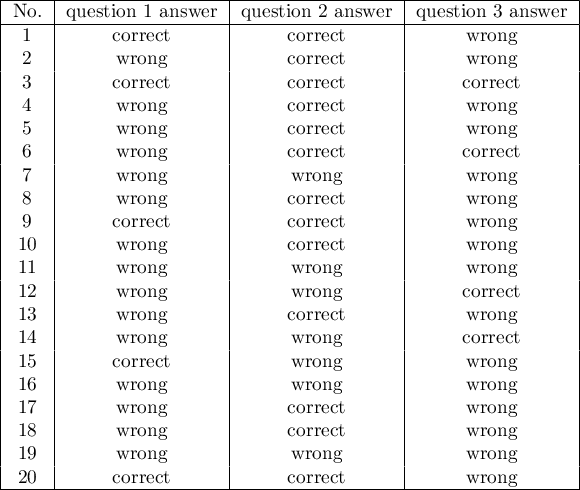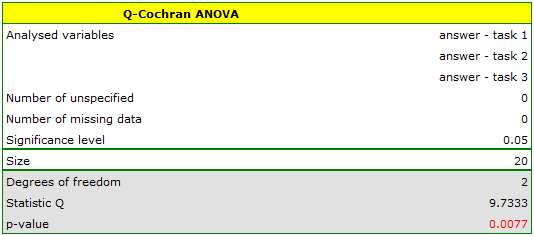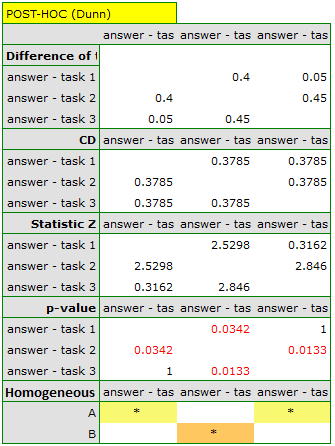Narzędzia użytkownika
Narzędzia witryny
Pasek boczny
en:statpqpl:porown3grpl:nparpl:anova_qcochrpl
The Q-Cochran ANOVA
The Q-Cochran analysis of variance, based on the Q-Cochran test, is described by Cochran (1950)1). This test is an extended McNemar test for  dependent groups. It is used in hypothesis verification about symmetry between several measurements
dependent groups. It is used in hypothesis verification about symmetry between several measurements  for the
for the  feature. The analysed feature can have only 2 values - for the analysis, there are ascribed to them the numbers: 1 and 0.
feature. The analysed feature can have only 2 values - for the analysis, there are ascribed to them the numbers: 1 and 0.
Basic assumptions:
- measurement on a nominal scale (dichotomous variables – it means the variables of two categories),
Hypotheses:

where:
„incompatible” observed frequencies – the observed frequencies calculated when the value of the analysed feature is different in several measurements.
The test statistic is defined by:

where:
 ,
,
 ,
,
 ,
,
 – the value of
– the value of  -th measurement for
-th measurement for  -th object (so 0 or 1).
-th object (so 0 or 1).
This statistic asymptotically (for large sample size) has the Chi-square distribution with a number of degrees of freedom calculated using the formula:  .
.
The p-value, designated on the basis of the test statistic, is compared with the significance level  :
:

The POST-HOC tests
Introduction to the contrasts and the POST-HOC tests was performed in the unit, which relates to the one-way analysis of variance.
For simple comparisons (frequency in particular measurements is always the same).
Hypotheses:
Example - simple comparisons (for the difference in proportion in a one chosen pair of measurements):

- [i] The value of critical difference is calculated by using the following formula:

where:
 - is the critical value (statistic) of the normal distribution for a given significance level
- is the critical value (statistic) of the normal distribution for a given significance level  corrected on the number of possible simple comparisons
corrected on the number of possible simple comparisons  .
.
</WRAP
- [ii] The test statistic is defined by:

where:
 – the proportion
– the proportion  -th measurement
-th measurement  ,
,
The test statistic asymptotically (for large sample size) has the normal distribution, and the p-value is corrected on the number of possible simple comparisons  .
.
The settings window with the Cochran Q ANOVA can be opened in Statistics menu→ NonParametric tests→Cochran Q ANOVA or in ''Wizard''.

Note
This test can be calculated only on the basis of raw data.
We want to compare the difficulty of 3 test questions. To do this, we select a sample of 20 people from the analysed population. Every person from the sample answers 3 test questions. Next, we check the correctness of answers (an answer can be correct or wrong). In the table, there are following scores:

Hypotheses:


Comparing the p value p=0.0077 with the significance level  we conclude that individual test questions have different difficulty levels. We resume the analysis to perform POST-HOC test by clicking
we conclude that individual test questions have different difficulty levels. We resume the analysis to perform POST-HOC test by clicking  , and in the test option window, we select POST-HOC
, and in the test option window, we select POST-HOC Dunn.


The carried out POST-HOC analysis indicates that there are differences between the 2-nd and 1-st question and between questions 2-nd and 3-th. The difference is because the second question is easier than the first and the third ones (the number of correct answers the first question is higher).
1)
Cochran W.G. (1950), The comparison ofpercentages in matched samples. Biometrika, 37, 256-266
en/statpqpl/porown3grpl/nparpl/anova_qcochrpl.txt · ostatnio zmienione: 2022/02/13 17:35 przez admin
Narzędzia strony
Wszystkie treści w tym wiki, którym nie przyporządkowano licencji, podlegają licencji: CC Attribution-Noncommercial-Share Alike 4.0 International

